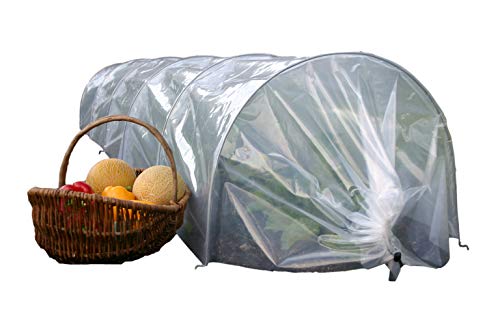Gardeners typically extend their vegetable harvest by keeping their plants from being frosted or frozen at the end of the growing season.
Another option is to start earlier in the season by planting vegetables that prefer to grow in cold or cool weather. Extend your early-season harvest by planting early crops like the leafy greens, onions, turnips, peas, cabbage, broccoli, potatoes, and more.
Early spring vegetable gardening can have the same challenges as a late-season garden: protecting your garden plants from the really cold weather. Even though you're planting vegetable transplants or seeds where they prefer cold or cool weather, they cannot survive hard freeze or frost for very long. Gardeners can use those same old sheets and blankets or sheets of plastic to protect their plants in the spring, just as is done in the late fall.
Another way to extend the season is to use parts of your landscape or yard, benefiting from those microclimates that every home has. Soils, for example, warm up sooner on the southern or western exposures of your home than on the eastern or northern side of the home.
You might have a back corner or part of the side landscape available. Consider planting a small number of seeds or transplants in those areas. Think of them as mini gardens maybe containing only one or two kinds of vegetables getting you off to a good early start while the main garden is just underway.
As the season continues to warm, gardeners will be planting more for the main season. During this time, gardeners can plant successive plantings in the spots where the early crops of cabbage, early peas, and leafy greens had been, getting more out of the same space, extending the harvest even more.
Some vegetables can take up lots of space. Gardeners could grow vine crops on a vertical trellis, leaving more ground space for successive plantings of snap beans, for example, allowing a longer harvest of beans. If a trellis is not in the picture, grow the space-saver varieties that do not use up your entire garden, leaving room for your other vegetables."
There are vegetables and herbs that have colorful foliage and can add to the visual interest in the landscape, plus you are growing something to eat too.
A landscape bed may be just the right place for vine crops taking up so much space or some of the longer-season vegetables like chard, Indian corn or brussels sprouts, or perennial crops like rhubarb with its large leaves, or asparagus with its fine, fernlike foliage.
The final point on extending the harvest in the fall is to remember to save only the best for long term storage.
Harvest and handle your vegetables with care as every bruise lessens the time you are allowed to store that vegetable. If storage is not an option, you can leave certain root crops right in the garden, mulched before the ground freezes. Then you can go out and dig them up as you need them during the winter months.


